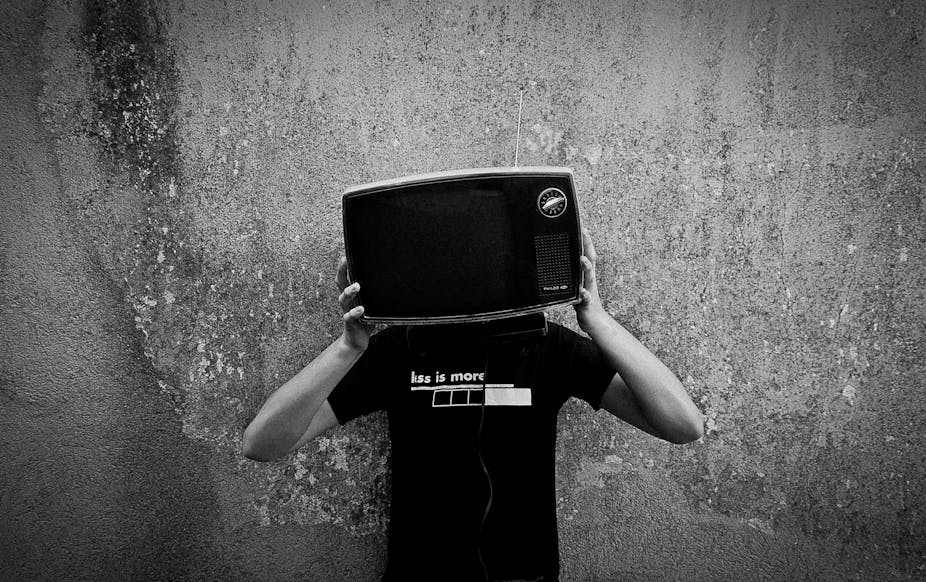In case anyone has missed the advertisements, Gogglebox has just hit Australian television screens. Based on the UK series of the same name – now a global format – Gogglebox is a new type of reality TV that seems to stretch the limits of credibility. Its meta-TV: a show that watches people watch.
Its UK creators say it’s not about TV at all, but rather, human emotion, family dynamics and interpersonal relationships.
This summation rather misses the point. Gogglebox is most definitely about TV and its entwining with everyday life – how contemporary existence shapes itself around ubiquitous media forms. It is also about how we see (into) television.
Gogglebox grabs our attention because it allows us to see into seeing. It puts faces on view – eye movements, mouthing lips, frowns and smiles – elements that eye-tracking research shows are key to human interest.
Gogglebox also connects visual processing to emotion, context and conversation: what’s happening in the minutiae of the living room affects viewing behaviours just as much as storylines, camera work and editing.
It is just this type of environmental and embodied screen processing that interests us as members of the diverse, multidisciplinary team involved in the Melbourne-based Eye Tracking and the Moving Image Research Group (ETMI).
Since it formed in 2012, the group has tracked subjects watching a range of animated and live-action films, and television series, launched a special edition of online journal Refractory and, in the same week that Gogglebox Australia kicked off, hosted the Seeing into Things symposium in association with Objective Experience, and Screen Cultures at RMIT University.
As a group we use eye tracking to help explore the contours, stories, spaces and interactions that unfold in our movies and television series and serials – allowing us to analyse how people watch, hear, sense and make sense of moving images.
But what can the science of eye tracking tell us about film and television as embodied art forms? How to wrestle with the collision between empirical data and the sensory transformations that take place between viewers and screen? How to best bring the forces of science and the alchemy of art together to make better sense of watching people watch?
While eye-tracking technology provides moving image researchers with accurate visualisations of where people look, in what sequential order, and for what duration, it can tell us very little about what people are feeling, thinking, or memorialising as they watch – to do that we needed to draw on other research methods.

We second that emotion
Film and television are embodied art forms: their pleasures reside in their ability to awaken our senses. Emotion runs like a river through the moving image and flows in both unconscious and experiential ways. Deep-seated memories are activated, traumas ignited, and one’s heart rate quickens and breathing rate changes when the emotion of the moving image floods through us or soaks under our porous skin.
In Under the Skin (2013), a baby is left to die on a desolate beach.
We see him sitting on the edge of the surf with the light fading and the tide edging closer. He sobs and this sound carries over into the rocky shoreline when he is no longer visible, haunting the film as it does so. As we struggle to come to terms with his impending death, the scene activates a range of primordial feelings and it becomes literally difficult to breathe so overtaken is one by the horror of it all.

What if we were to draw upon a range of supportive methods to understand the full range of processes and transformations that are taking place as the scene is being watched?
Eye-tracking visualisations would provide us with robust data on where viewers were looking and for how long – did they look at the baby’s face, for example, or “look away”? Heart rate and breathing monitors would allow us to measure physiological changes that viewers underwent as the scene progressed.
Post-screening interviews, playback, and focus groups would allow us to draw out their own conscious and unconscious responses to the scene. And “matching” all these elements would allow us to put together a threaded and layered assessment of the emotional pull of the scene.
This would allow both a movement towards and away from the science of the eye, of cognition and physiological transformation, while engaging also with the poetics of the image and the senses it evokes. Hard data would meet the soft skin of feeling.
Seeing into things
At our aforementioned symposium, researchers in marketing and education went head to head with language scholars, film theorists, ethnographers, cognitive scientists and psychologists. And while much discussion chewed over methodological challenges posed by the ETMI group’s heady mix of art and science, this recipe also revealed its sweet spot.
It is precisely through the ungainly combination of emotion, affect and cognitive processing that this local research group promises to forge new knowledges.
A central item of interest at the symposium concerned how eye tracking might be enriched by combining it with measurement of other physiological and cardio-vascular responses, such as pupil dilation, heart and breathing rates.
Others sought to read eye tracking “against the grain”, focusing on its empirical lacunae and ability to bring into the picture screen peripheries, vision blindness and atypical viewing behaviours.
This type of open-ended engagement with eye tracking is a key driver in our research as we have come to realise, passionately, that science and art, and the range of sub-disciplines that sit within these broad houses, need to be brought together to throw light and illumination onto audience studies.
It is in the fusion between empirical, positivist enquiry and hermeneutic interpretation or sensory exploration that the truth of viewing emerges, and we get under the skin of “Goggleboxing”.

